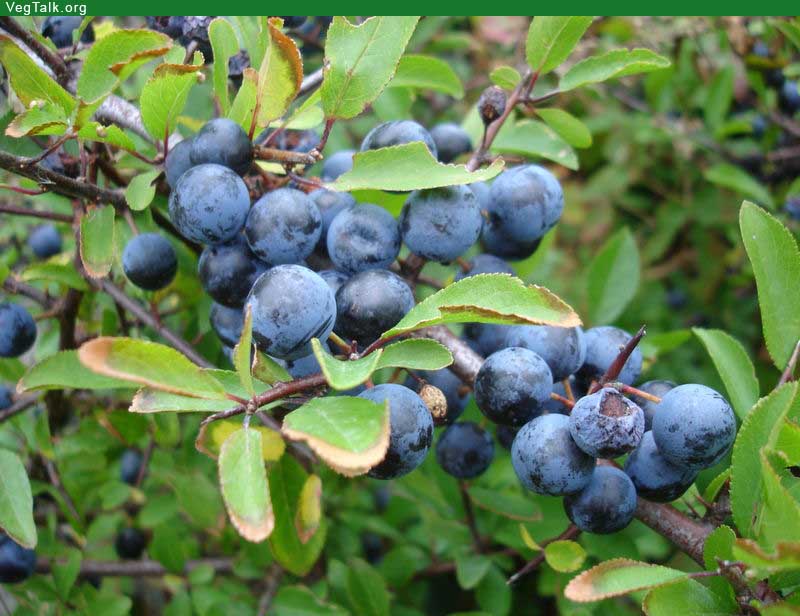
General info about Fruit
The Blackthorn is a large shrub or a small tree of the genus Prunus, botanically Prunus spinosa. Its fruit is called the sloe, or in the Scots language, slaes.
The blackthorn is native to Europe, western Asia, and north Africa. The common name is derived from its dark bark and skin, and from the thorns or spines that it bears. In Ireland, a straight blackthorn stem is traditionally made into a walking stick named a Shillelagh. A Shillelagh (pronounced “shi-LAY-lee”) is a wooden club or cudgel, typically made from a stout knotty stick with a large knob on the end
It is covered in white flowers in early spring, and is often the first flowering tree in the countryside in its native regions. It bears a fruit called the sloe, which is similar to a small damson or plum, suitable for preserves, but too tart to eat (unless deeply frozen, as it is practiced in Eastern Europe); in rural England so-called sloe gin is made from them, though this is not a true gin but a liqueur. In Navarra, Spain, patxaran is a popular liqueur made with sloes. Sloes can also be made into jams and if preserved in vinegar are similar in taste to Japanese umeboshi.
How to choose a ripe and fresh Fruit
The fruit, which is sweet and edible, is about half an inch long, bluish black, covered with a bloom, and ripens in early autumn. It contains a somewhat flattened stone.
Ways to prepare and serve the Fruit
Edible Uses
Edible Parts: Flowers; Fruit; Seed.
Edible Uses: Tea.
Fruit - raw or cooked. Exceedingly astringent, it is normally cooked but once the fruit has been frosted it loses some of its astringency and some people find they can enjoy it raw. The fruit is more usually used in jellies, syrups, conserves etc and as a flavouring for sloe gin and other liqueurs. Some fruits that we ate in December were fairly pleasant raw. In France the unripe fruit is pickled like an olive. The fruit is about 15mm in diameter and contains one large seed. Seed - raw or cooked. Do not eat the seed if it is too bitter - see the notes above on toxicity. The leaves are used as a tea substitute. The dried fruits can be added to herbal teas. The flowers are edible and can be crystallised or sugared.
Health Benefits and Warnings of eating Fruit
Medicinal Uses
Aperient; Astringent; Depurative; Diaphoretic; Diuretic; Febrifuge; Laxative; Stomachic.
The flowers, bark, leaves and fruits are aperient, astringent, depurative, diaphoretic, diuretic, febrifuge, laxative and stomachic. An infusion of the flowers is used in the treatment of diarrhoea (especially for children), bladder and kidney disorders, stomach weakness etc. Although no specific mention has been seen for this species, all members of the genus contain amygdalin and prunasin, substances which break down in water to form hydrocyanic acid (cyanide or prussic acid). In small amounts this exceedingly poisonous compound stimulates respiration, improves digestion and gives a sense of well-being.
Other Uses
Cosmetic; Dye; Hedge; Ink; Pioneer; Tannin; Wood.
The bark is a good source of tannin. It is used to make an ink. The juice of unripe fruits is used as a laundry mark, it is almost indelible. The pulped ripe fruit is used cosmetically in making astringent face-masks. A green dye can be obtained from the leaves. A dark grey to green dye can be obtained from the fruit. The bark, boiled in an alkali, produces a yellow dye. The sloe is very resistant to maritime exposure and also suckers freely. It can be used as a hedge in exposed maritime positions. The hedge is stock-proof if it is well maintained, though it is rather bare in the winter and, unless the hedge is rather wide, it is not a very good shelter at this time. Because of its suckering habit, the plant is a natural pioneer species, invading cultivated fields and creating conditions conducive to the regeneration of woodland. Wood - very hard. Used for turnery, the teeth of rakes etc. Suitable branches are used for making walking sticks and are highly valued for this purpose because of their twisted and interesting shapes.
Classification
Scientific classification
Kingdom:Plantae
Division:Magnoliophyta
Class: Magnoliopsida
Order: Rosales
Family: Rosaceae
Subfamily:Prunoideae
Genus: Prunus
Species:P. spinosa